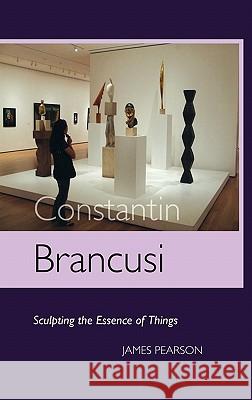Constantin Brancusi: Sculpting the Essence of Things » książka
Constantin Brancusi: Sculpting the Essence of Things
ISBN-13: 9781861712684 / Angielski / Twarda / 2010 / 180 str.
Constantin Brancusi: Sculpting the Essence of Things
ISBN-13: 9781861712684 / Angielski / Twarda / 2010 / 180 str.
(netto: 149,97 VAT: 5%)
Najniższa cena z 30 dni: 157,04
ok. 16-18 dni roboczych
Dostawa w 2026 r.
Darmowa dostawa!
CONSTANTIN BRANCUSI
Constantin Brancusi is one of the greatest of all sculptors, and a key sculptor of the modern era, with Auguste Rodin and Pablo Picasso. Brancusi's influence can be seen in a wide range of Western sculptors, including Donald Judd, Carl Andre, Henry Moore, Jean Arp, Barbara Hepworth, Minimalists and land artists.
This new book studies the religious and mythical dimensions of Constantin Brancusi's distinctive scultpural forms, the 'eggs', 'fishes', 'heads' and 'columns'. His central quest was for the 'essence of things', which resulted in purifying a form until only the essence was left.
It was Constantin Brancusi's project to strip away the detritus that had accumulated around sculpture, Henry Moore said, and to offer the pure, simple shape. What Brancusi did was 'to concentrate on very simple shapes, to keep his sculpture, as it were, one-cylindered, to refine and polish a single shape to a degree almost too precious.'
As well as being a sculptor, Constantin Brancusi was also an accomplished photographer. Quite a few artists (not all of them sculptors) have expressed for Brancusi's photographs, and the way he would set up his sculptures inhis studio and photograph them at particular times of the day, when the lightingwas just right. They are early examples of installation art (and some of the best, too). Andy Goldsworthy said he admired how Brancusi created the right conditions in his studio so that his work 'comes alive at a particular time of the day as the light momentarily touches it'. For Goldsworthy, Brancusi's works were at their best when they were arranged by the sculptor in his studio and photographed. Somehow, it wasn't quite the same when they were displayed in modern art museums (such as the Pompidou Centre in Paris or the Museum of Modern Art in Gotham, which have important Brancusi pieces).
Fully illustrated, including many photos of Brancusi's studio in Paris, and the art of his contemporaries."
CONSTANTIN BRANCUSI
Constantin Brancusi is one of the greatest of all sculptors, and a key sculptor of the modern era, with Auguste Rodin and Pablo Picasso. Brancusis influence can be seen in a wide range of Western sculptors, including Donald Judd, Carl Andre, Henry Moore, Jean Arp, Barbara Hepworth, Minimalists and land artists.
This new book studies the religious and mythical dimensions of Constantin Brancusis distinctive scultpural forms, the eggs, fishes, heads and columns. His central quest was for the essence of things, which resulted in purifying a form until only the essence was left.
?It was Constantin Brancusis project to strip away the detritus that had accumulated around sculpture, Henry Moore said, and to offer the pure, simple shape. What Brancusi did was to concentrate on very simple shapes, to keep his sculpture, as it were, one-cylindered, to refine and polish a single shape to a degree almost too precious.
?As well as being a sculptor, Constantin Brancusi was also an accomplished photographer. Quite a few artists (not all of them sculptors) have expressed for Brancusis photographs, and the way he would set up his sculptures in his studio and photograph them at particular times of the day, when the lighting was just right. They are early examples of installation art (and some of the best, too). Andy Goldsworthy said he admired how Brancusi created the right conditions in his studio so that his work comes alive at a particular time of the day as the light momentarily touches it. For Goldsworthy, Brancusis works were at their best when they were arranged by the sculptor in his studio and photographed. Somehow, it wasnt quite the same when they were displayed in modern art museums (such as the Pompidou Centre in Paris or the Museum of Modern Art in Gotham, which have important Brancusi pieces).
Fully illustrated, including many photos of Brancusis studio in Paris, and the art of his contemporaries.











